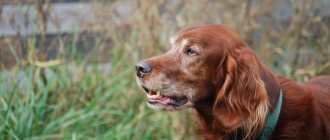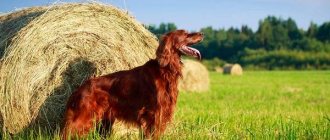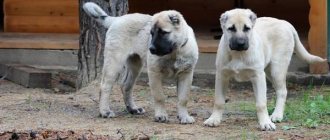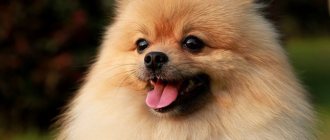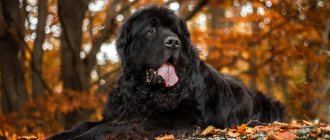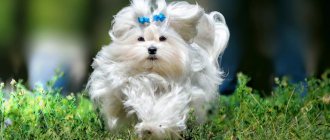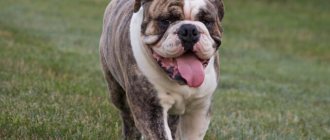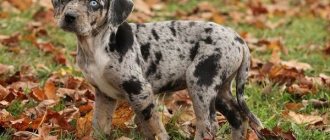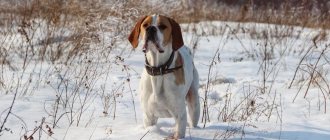Description and features
The Irish Wolfhound dog is massive, fluffy and a little clumsy. She always attracts people's attention. It often causes horror, but more often it causes tenderness and delight. Nature has endowed such an animal with charm and the ability to win over.
This will surprise many people who are not familiar with this breed, but they are one of the kindest creatures on earth. Their disposition is cheerful, welcoming and friendly. At home, such dogs are not at all aggressive. On the contrary, they strive, at all costs, to please their household.
A wolfhound's devotion to its owner is limitless. A dog sincerely loves the person who raised it and always protects him. The animal's loyalty served as a reason for its exploitation in the military sphere. Yes, it is not aggressive, but it can kill a person if the owner so desires.
For example, during the First World War, Irish wolfhounds were trained to kill enemy infantrymen and horsemen. During the jump, the dog knocked the man out of the saddle and gnawed his throat. That's the story.
Today's representatives of the breed are more loyal to people. They are adequate, easy to control and predictable. The complete deprivation of aggression from the wolfhound is the result of long-term selection of the breed. That's why he's a great companion today. These dogs are frequent guests and participants in exhibitions, sports competitions and competitions. For example, they regularly take part in agility.
Breeders of Irish wolfhounds claim that their dogs have watchdog abilities. This is how they try to arouse more buyer interest in this breed and stimulate its sales. In fact, this is only partly true.
Yes, a large fluffy dog really protects the territory where his family lives, but he himself does not realize it. We are talking exclusively about visual intimidation of strangers. Few people dare to cross the territory guarded by a huge four-legged animal. Conclusion: the wolfhound is repelled only by its appearance.
In England, representatives of this breed are exploited as service animals. Members of the royal family have had them for many years, but not only for service, but more for camaraderie.
The interesting thing is that this is one of the oldest breeds. Experts believe that it existed more than 350 BC. In Ireland, wolfhounds are valued to this day, where they are considered the property and pride of the country. Previously, these huge animals accompanied the nomadic Celts and protected them from attacks by other tribes.
In ancient Rome they entertained the crowd. Dogs were trained against each other and fights were arranged between them. Today, almost everyone knows about this dog. She is valued, respected and loved for a lot of positive character qualities.
History of the origin of the Irish Wolfhound breed
Irish Wolfhounds are considered one of the most ancient dog breeds. Their ancestors, wire-haired greyhounds, were known in Ancient Egypt in the 2nd millennium BC. e. They were used in hunting, in gladiatorial fights, and served in the army. Such dogs were brought to Ireland by the Celts. At first they were smooth-haired and wire-haired, then, due to the climate, only wire-haired individuals remained. When breeding, they did not pay much attention to appearance; working qualities were more important.
In the 15th century, dogs of this breed began to be called wolfhounds. They were kept in all farms to exterminate wolves. These dogs were highly valued for their fearlessness and endurance. It is often said that the disappearance of wolves in Ireland was due to their work. There are many legends associated with wolfhounds. They are glorified in the Viking epic; according to legend, they accompanied the patron saint of Ireland - St. Patrick. In one city in Wales, a monument was erected to a representative of this breed.
A wolfhound puppy was considered a valuable gift; they were given to kings. The breed was known and popular abroad. But in the middle of the 17th century it was forbidden to take these dogs out of the country. By the beginning of the 18th century, the number of Irish greyhounds had greatly decreased. This was due to a decrease in the number of portages and isolation of the breed.
The revival of Irish greyhounds began in the 19th century. A national club was created. The breeder was Georg Graham. To improve the breed, he crossed wolfhounds with Deerhounds and Great Danes. This breeder created the first breed standard and called it the Irish Wolfhound.
At the end of the 19th century, the breed was registered by the American Kennel Club. Since the beginning of the 20th century, these dogs have served in the Royal Guards of Ireland. This breed is a national treasure of the country. Nowadays Irish wolfhounds are no longer used for hunting. These are mainly companions and show dogs. In Russia, the breed became known only in the 80s of the 20th century, but it is still rare. Distributed mainly in its homeland.
Similar breed
Irish Wolfhounds belong to the greyhound group. Therefore, these dogs are sometimes called Irish Wirehaired Greyhounds. Another breed that belongs to the same group is the Scottish Deerhound or Deerhound. Researchers believe that she was bred with the participation of Irish greyhounds.
At first glance, it is difficult to distinguish representatives of these breeds, they are so similar. But there is still a difference. Unlike Scottish greyhounds, Irish greyhounds are stronger, taller, with a dense, muscular build. They often have a straw-wheaten color, which is rare in the Deerhound.
These breeds also differ in character and purpose. The Irish Wolfhound was bred to kill wolves and protect humans. He has a more reserved, calm character. Unlike the Deerhound, this greyhound has poor health and a short life expectancy.
The photograph shows the differences between Irish Wolfhounds and Deerhounds:
Breed standard
For many years, experts did not come to a consensus on the standardization of the Irish Wolfhound breed. It was only in 2001 that it was precisely defined. It was decided to classify the dog as a hunting greyhound. Without a doubt, she is one of the largest four-legged pets.
Strong muscles run along the entire body of the dog, but this does not prevent it from looking slender. The maximum height at the withers of an adult representative of the breed is 80 cm. Bitches are slightly lower, up to 72 cm. A male dog weighs from 62 to 74 kg, and a female dog weighs from 43 to 65 kg. If the height of a male is 80 cm, then his permissible body weight is 75 kg. But such individuals are rarely born.
Nature has endowed the furry giant hunters with a slender physique. They have an elongated body, a moderately wide back, a lean belly and a slightly elongated neck with a clearly defined curve. There is also a bulge in the lumbar region. The tail of the animal is hanging, long, covered with hair.
By the way, about fur. In a wolfhound, it is hard, of medium length, and grows throughout the body, even on the muzzle. The dog's legs are long and slender. The muscles on them are well developed. Thanks to this, the animal moves gracefully, smoothly, and runs incredibly fast.
His head is moderately large. The eyes are large and brown. The Irish Wolfhound in the photo looks like a cheerful, big guy. His gaze is penetrating but good-natured. The nose is dark and large. The tongue is bright pink. The teeth are strong and white.
Breed traits
Breed traits (on a 5-point scale)
| Irish Wolfhound | |||
| Activity | in the house | 2.1 | |
| on the street | 3.6 | ||
| Obedience | training | 2.9 | |
| strangers | 4.3 | ||
| Domination | in family | 1.6 | |
| over dogs | 2.9 | ||
| Defending your territory | from people | 2.6 | |
| from dogs | 3.6 | ||
| Sociability | in family | 4.9 | |
| with strangers | 3.1 | ||
| with dogs | 3.4 | ||
| Concentration | in family | 2.1 | |
| in front of strangers | 3.3 | ||
| with dogs | 2.4 | ||
| Aggressiveness | in family | 1 | |
| to strangers | 1.9 | ||
| to the dogs | 2 | ||
| to cats | 1.7 | ||
| Family behavior | calmness | 3.7 | |
| demand for affection | 4 | ||
| excitability | 2.7 | ||
| playfulness | 3 | ||
| excessive barking | 1.4 | ||
| behavioral breakdowns | 1.4 | ||
| Tolerance for children | up to 4 years | 3.7 | |
| over 4 years old | 3.9 | ||
| Institutional use | watchman | 2.1 | |
| bodyguard | 2.1 | ||
This breed is often compared to the following dog breeds: Deerhound (Scottish Deerhound), Great Dane, German Shepherd, Black Russian Terrier, Caucasian Shepherd.
The photo shows what Irish wolfhounds look like next to a person:
Kinds
One type of breed was standardized (in 2001). There are no variations. However, Irish Wolfhounds can be divided depending on the shade of their coat. The following color options are acceptable:
- Pure black.
- Pure white.
- Reddish-sandy.
- Brindle.
- Gray-blue.
- Ginger.
- Golden.
- Gray with tan.
This is not a complete list. Regardless of the shade, the coat of such a dog is hard and requires special care.
The most common diseases
Irish Wolfhounds are extremely active. Their joints and blood vessels are at greater risk. Problems with the musculoskeletal system are the most common.
List of common diseases:
- Bruises, sprained paws;
- Osteochondrosis;
- Volvulus;
- Atrial fibrillation;
- Gastric volvulus;
- Ophthalmic diseases.
To avoid diseases, pets are vaccinated on time and monitored for daily physical activity and nutrition. Carry out regular inspections and consult with specialists.
Character
These are very loving dogs, whom Mother Nature has endowed with charisma and charm. They are affectionate, kind and incredibly gentle. They can sit at the owner’s feet for hours, asking for attention and touch.
The look of a wolfhound is the parameter by which one can determine its mood and degree of affection. If the animal looks at you for a long time and piercingly, then know that he loves you infinitely. But the lack of eye contact between a dog and a person indicates the absence of a strong emotional relationship between them.
Note! Direct eye contact is perceived by the dog as a challenge. You can look at her for a long time, but remember to periodically turn away or blink. If you do not follow this rule, the animal will feel awkward.
Do not forget that the Irish Wolfhound is, first of all, a formidable hunting hound. He is characterized by ferocity and a desire to kill his prey. But this set of qualities applies only to predatory animals, but not to people.
However, driven by the instinct to protect beloved household members, he can attack a person and even cause serious damage to him. We are talking about intruders and suspicious strangers.
The British, who use wolfhounds as home bodyguards, specifically train them on people, awakening natural aggression. In most cases this is effective. Such a dog is capable of making decisions independently, although it tends to trust its owners.
That is, if it comes to protecting her loved ones, she will not hesitate and will boldly rush to their defense. However, it is a mistake to think that all wolfhounds without exception (including the Caucasian and Central Asian Shepherd Dogs) are aggressive by nature. They are rather adequate. It is important to properly raise such an animal so that it clearly assesses the situation and shows responsibility if the situation requires it.
However, we strongly advise against angering the Irish Wolfhound, for example by shouting at it or hitting it. Yes, he will not attack a person for no reason, but he will definitely demonstrate to him his reluctance to further interaction. He may growl, strike with his teeth, or poke his muzzle.
The Irish Wolfhound is considered to be one of the most loyal dog breeds. He adores his owner and all members of his “pack”. He treats them with respect, is afraid of offending them, and shows patience and tenderness. He communicates especially cordially with children, even infants. Loves to fall asleep next to them and have fun. The kids are allowed to lie on themselves and pull the hairs.
Separation from its beloved owner is incredibly distressing for this animal. Because of melancholy, it can even die (many such cases are known). You can leave such a dog alone for no more than a few hours.
Otherwise, he will become depressed. Communication with family members is vital for him. He feels happy only if he is next to them, literally.
The Irish Wolfhound is very active and playful. He doesn't like to spend time quietly lying on the lawn. He would prefer to run around the yard and play with the children. It can also make friends with some of its owner’s pets, especially small ones. Jealousy is not characteristic of him.
Personality of Irish Wolfhounds
Irish Wolfhounds are large, menacing, but good-natured and peace-loving dogs. Despite the fact that they were bred to hunt and exterminate wolves, there is no aggression in their character. They are kind to people and other animals. They communicate calmly with small dogs and even cats if they live in the same house with them. Although, without proper upbringing, a wolfhound will chase birds and small animals on the street.
Irish Greyhounds can be described as follows:
- friendly;
- devotees;
- affectionate;
- balanced;
- smart;
- independent;
- patient;
- tactful;
- hardy;
- fearless;
- reserved.
At home, the Irish Wolfhound behaves calmly. Very attached to the owner and other family members. Ready to be around all the time, to play, but will never intrude. This is an affectionate, friendly pet. He is obedient, tries to fulfill the owner’s demands, but will never humiliate himself and beg for a treat. This dog is not jealous, but touchy and sensitive. He takes undeserved punishment very painfully. With age, he can become lazy and moody. And representatives of the breed age quickly; already at 6-7 years old they sleep most of the time.
The Irish Wolfhound treats children tenderly, kindly and condescendingly. I am patient with them and allow everything. Even if a child hurts a dog, it will never bite. Becomes a nanny and devoted protector. But due to his large stature, he can accidentally push or injure a child.
The wolfhound is wary of strangers at first, but is never the first to show aggression. It was bred to protect people from predators. Therefore, he behaves peacefully with everyone. But if the dog feels threatened, he will boldly rush to defense. Wolfhounds do not tolerate rudeness, shouting and aggressive behavior. If the owner behaves this way, he will be offended and very worried. But in response to such behavior, a stranger may attack.
Features of education and training
Special training is not required for the Irish Greyhound, although it is recommended to undergo OKD with it. The ZKS course is not suitable for wolfhounds, since they do not show aggression towards humans and will not make a good bodyguard or security guard. It is also not recommended to engage in many dog sports with representatives of this breed: due to their large size, they often have problems with the spine. Suitable for this greyhound are coursing and obedience.
The Irish Wolfhound is an intelligent, quick-witted dog. He easily remembers commands, but not everyone can train him correctly. The breed is not suitable for inexperienced owners or people with a soft character. It is important to build a relationship with this dog based on mutual respect. Dog handlers recommend communicating with her as equals.
When training, it is necessary to take into account that the Irish Wolfhound does not tolerate drilling or frequent repetition of the same commands. It is recommended to work through them no more than 2-3 times, then take a break or switch to another activity. There are a few more rules for properly raising this dog:
- training should be regular, preferably short, but several times a day;
- Give commands in a calm, even voice; you must not shout;
- these dogs do not tolerate rudeness or aggressive behavior towards themselves; physical punishment is also unacceptable;
- For wolfhound puppies, physical overload is very dangerous - it negatively affects the immature musculoskeletal system.
The upbringing and socialization of a puppy must begin from the first days of its arrival in its new home. First, they accustom them to a nickname, place, and diet. You need to show the dog who is boss in the house. The baby must learn to come to me on command, know the rules of behavior and prohibitions. When, after all the vaccinations, the puppy is taken outside, he should already be able to walk calmly on a leash and obey the commands “near” and “stay.” You can let go off the leash only when these commands are carried out unquestioningly.
Irish Wolfhound puppies have a strong biting reflex. They try to taste everything: things, furniture, people's hands and feet. They need to be weaned off this immediately by showing the baby what can and cannot be chewed. To do this, buy more toys and chewing bones. Representatives of the breed are also very sociable and love to jump on people. This should also be weaned off immediately, since friendly hugs from a huge dog will not lead to anything good.
When practicing prohibitions, you should not shout at the puppy or hit him. With this attitude, he will grow up nervous, intimidated and even angry. You need to divert your pet's attention and show him that such behavior is unacceptable. Wolfhounds are sensitive and smart. When raised, they perceive encouragement and affection better.
Care and maintenance
It's hard to imagine a huge shaggy dog living in an apartment. It will definitely be cramped for him there. Therefore, if you are a fan of this breed, you definitely need to live in a house with a large territory.
To stay strong and healthy, the Irish Wolfhound should run a lot. He needs to be exposed to physical activity every day. If you don't have enough time for this, try to take your pet to the training area on weekends. There he has to jump over barriers, chase a stick and just run around a lot.
If you are involved in athletics, great, take your dog with you to training! He will be very happy to keep you company. Also, do not forget to “arm” him with toys that you will throw forward. He must bring them. This is an effective and fun workout.
The coat of such dogs is very hard, therefore, in the absence of appropriate care, it loses its presentable appearance. It must be combed daily with a massage brush. It's better to do this twice a day.
The optimal number of annual baths for a wolfhound is 1. If the dog takes part in an exhibition, then it should be washed with shampoo before each event. Additional care measures:
- Grinding claws.
- Cleaning the mouth from food debris.
- Removing plaque from teeth.
- Removing dirt from the pads of your feet.
- Cleaning ears from dust and wax.
A dog that is properly and consistently cared for rarely gets sick and lives longer. The Irish Wolfhound is a purebred dog that must have a collar. Usually, red or pink collars are bought for females, and darker ones, blue, for example, are bought for males. This animal must also have a long leash. It attaches to the collar. The dog needs such “equipment” for a walk.
Putting him on a chain is contraindicated! Service with a disability makes the dog unhappy. If you force her to live and sleep near the booth, you will become a source of severe psychological trauma. However, the furry big guy should still have an enclosure.
The animal must understand that sometimes it will be locked there and that this is normal. The enclosure must have an insulated booth (you can throw fresh straw in there). A bowl of water should also be placed there. Remember, mineral water should be freely available to the animal!
Walks: Highlights
Walking time:
- For adults – 1 hour 2 times a day.
- For puppies under 6 months of age – 15 minutes every 3 hours.
Use a belt leash. The dog is allowed to be released in a safe place where nothing poses a threat to it; she is not a threat to others. It is worth remembering that Irish wolfhounds are not averse to running after street cats.
When walking, pets should not be overtired by excessive physical activity. They should also be protected from parasites.
Nutrition
Keeping a huge hunting dog is not a cheap pleasure. He weighs about 65 kg and must eat at least 2 kg of food per day. Therefore, the main source of expenses for the owner of such a pet is food.
There are 2 methods of feeding a large purebred dog - dry food and natural food. The first option is much simpler for obvious reasons. Few people want to spend several hours a day preparing various dishes for their dog, standing at the stove in any weather.
An Irish Wolfhound puppy can also eat food, but only in small portions, about 300 grams per meal. He should eat 4 to 7 times a day. In addition to dry food, be sure to feed him raw chicken/turkey meat and pasteurized milk. These 2 products are natural sources of calcium, iron and protein, so they should definitely be in your young pet’s diet.
An adult dog of this breed can be fed dry food regularly. For 1 meal, pour him 500-600 grams of this product. If the animal looks thin, it is recommended to increase the portion of food to 800-900 grams per meal. By the way, you should eat it twice a day. Never deny your four-legged pet the pleasure of enjoying ripe and juicy fruits, for example:
- Bananas.
- Strawberries.
- Watermelon.
- Peaches.
- Cherries.
- Melon.
- Pears, etc.
Wolfhounds eat a lot and indiscriminately. They will not disdain pasta, pastries, chocolate or even stale stew. But they are absolutely not allowed to do all this. From improper nutrition, the animal’s body quickly wears out, which is why it begins to get sick and dies prematurely.
Foods that dogs should not eat
- Fresh cow's milk;
- Chocolate;
- Onion and garlic;
- Raw river fish;
- Sweets;
- Butter, margarine;
- Sour cream;
- Sausage, smoked meat, salted lard;
- Boiled and raw bones;
- Pearl barley;
- Mushrooms;
- Vinegar;
- Seasonings and spices;
- Tubular bones of a bird;
- Bones of rabbits and sheep.
Pets' eyes also need care. They should be wiped with chamomile infusion at least once a week.
- Ears are cleaned of wax with cotton swabs and disks. Be sure to use veterinary lotion.
- Claws are trimmed as they grow.
- Use the teeth cleaning brush once a week.
- Dogs are prohibited from sleeping on hard surfaces.
Reproduction and lifespan
Unfortunately, the life expectancy of the Irish Wolfhound is short, a maximum of 10 years. Most representatives of the breed faithfully serve their owner for 8-9 years, even if they are completely healthy.
Puberty in dogs occurs early, up to 1-1.5 years. Males become sexually mature earlier than females, and even in puppyhood they show interest in them. Therefore, breeders separate males and females before they are 4-5 months old. A dog ready for breeding must be:
- High-breed.
- Over 1.5 years old.
- Completely healthy.
- Psychologically adequate, not aggressive.
- Friendly to people.
They match a male with a female on his territory. During the period of heat, the female becomes more aggressive, so she can push away the male. If this happens, the mating of the animals is postponed, but not for long. It is important to bring the dogs together in the middle of her heat stage, then she will most likely become pregnant. The female bears puppies for about 68-71 days.
Health: Highlights
Dogs live on average 7-10 years, up to 14 under good conditions.
- This breed loves movement. A sedentary lifestyle is harmful to your health. Every day you need to allocate at least two hours for physical activity.
- A huge, active dog needs a balanced diet. Feeding 2-3 times a day.
There is no need to calculate all the components if you give preference to special dog food.
When choosing a natural diet, you should include the following products in your diet:
- Lean meat (beef, lamb);
- Protein;
- Heat-treated vegetables;
- Fermented milk (cottage cheese);
- By-products;
- Poultry (turkey, chicken);
- Fish;
- Porridge (preferably: buckwheat, rice, oatmeal).
The food is crushed because it is difficult for dogs to chew it thoroughly. After a meal, pets need to lie down for an hour and a half. Playing fast after eating can lead to digestive problems.
Price
Purebred representatives of the breed can be found not only in Ireland, but also in Russia. The best wolfhound nurseries are located in St. Petersburg and Moscow. This is where we recommend making such a purchase.
The price of an Irish wolfhound with documents (veterinary passport and pedigree) is from 35 to 50 thousand rubles. An animal purchased from a nursery can bring its owner a good profit, of course, if he begins to regularly take care of its upbringing and appearance.
You can also use the services of private breeders. This way you can save money, but you will not get a guarantee of purchasing a healthy and high-quality dog. Private owners sell Irish wolfhounds from 15 to 25 thousand rubles.
How to buy an Irish Wolfhound puppy
The Irish Wirehaired Greyhound is a fairly rare breed. To purchase a purebred puppy, you need to find an official kennel. This is a guarantee that he will have all the necessary documents and vaccinations. The breeder must provide veterinary certificates and parental pedigrees. A purebred wolfhound puppy in Moscow costs from 35 thousand rubles. A representative of the show class or a descendant of champions can be bought for 60-100 thousand rubles.
Puppies are usually bought at 3-4 months, at this age their character begins to show. You need to pay attention to the living conditions of the animals, the behavior of the mother, and the activity of the babies. A healthy puppy is active and makes good contact. His eyes and ears are clean, there is no dandruff or rash, or unpleasant odor.
The photo shows what the puppies look like:
The video complements the description of the breed:
Video: Irish Wolfhound: everything about the breed - the story of the dog owner
Video: Irish Wolfhounds: all about the breed
Video: Irish Wolfhound: wolf fighter and one of the largest dog breeds. Interesting facts about dogs
Irish Wolfhounds are large but good-natured dogs. They are unpretentious and obedient. With the right approach, such a dog can become a best friend, a devoted companion.
Training and education
This is one of the smartest breeds! The owner of such a dog almost never faces any difficulties. But, you should familiarize yourself with the basic rules of interaction with a hound hunter.
So, you brought the wolfhound puppy home. From this moment his socialization in your home begins. In other words, the dog should fit harmoniously into the “pack”, that is, into your family. To do this, she will need the support of every person in the house.
Surround your baby with love and care so that he feels comfortable. Don't provoke him to aggression, give him peace if he's scared or upset. A puppy who has been separated from its mother will feel sad only on the first day of its new life. Then he will begin to forget her and get used to his new family. You shouldn’t be too protective of him at this stage.
Important ! In order for the dog to learn responsibility and the ability to make decisions independently, he should be given freedom of choice in the early stages of socialization. Don't look after him 24/7.
The Irish Wolfhound is a very smart dog that quickly remembers the rules, its name and basic commands. You can start training her within a week after the start of home socialization. It is advisable that the animal be trained by 1 person. This way it will be more disciplined. Now about the teams. We recommend teaching your dog:
- Give a paw.
- Lie.
- Roll over onto your back (“Freeze”).
- Sit.
- Voice (barking).
- Fetch (jumping over a barrier).
- Place.
- It is possible/not possible.
Since nature has endowed representatives of this breed with excellent intellectual potential, they can be trained in a comprehensive manner. Alternate tasks so that your dog remembers all the commands faster. How to teach her how to do them?
It's actually very simple! It is enough to help the dog take the desired position, for example, sit, and clearly say the name of the command out loud several times. Treat her to something tasty for her efforts. Next time, your pet will probably take the desired position on its own, without your help.
It is important to build a trusting relationship with your Irish Wolfhound before it matures. If a dog learns to respect you, then it will always listen unconditionally.
A maturing animal should be accustomed to an enclosure. Yes, he probably won’t want to go there, especially if there are guests at home. But the dog must occupy the last position in the hierarchical family niche, therefore, he should not have a choice.
Invite him to go to the enclosure every time he hears or sees a guest. The dog can greet household members in any way he likes, the main thing is not to knock them off their feet. Speaking of which. A large, massive animal rushing as fast as it can to greet its owner can be a big problem. Therefore, it is important to initially teach him to respond adequately to the arrival of the owner.
If you are not planning to lock the dog in the enclosure when you are expecting guests, then do not allow him to come close to them. Let the person who comes to the house decide for himself whether he wants to communicate with the animal.
Development and age-related changes
Up to 2 years of age, puppies grow quickly, gaining weight and increasing in size. Then they develop more slowly. It does not affect intelligence, learning or activity.
As dogs age, they can become irritable. “Old people” will increasingly prefer a quiet holiday in a cozy corner, but this does not mean that you can give up walks or pay less attention to your pet.
Possible diseases and methods of treating them
Pet diseases are divided into 2 types: genetic and acquired. Irish Wolfhounds have a rather weak musculoskeletal system, which makes their gait a little unsteady. A dog can easily lose its balance and fall, especially on slippery surfaces. A veterinarian should treat an injured animal.
Representatives of this breed have one more specific genetic disease - von Willebrand disease. It consists of involuntary nosebleeds. Also, ichor can periodically be discharged from the dog’s throat. If this happens infrequently, there is no need to panic. But regular hemorrhage in a dog should alert you. Be sure to show it to a specialist in this case.
Among the acquired diseases in wolfhounds are colds, helminthic infestations and cataracts. Preventive care will help minimize the risk of their occurrence. A couple of final tips: regularly give your dog tablets or capsules against parasites, and do not forget to vaccinate him against infections. Also inspect her body for ticks, especially in summer.
General characteristics of the Irish Wolfhound breed
Irish Wolfhounds are the national breed of Ireland and the mascot of the Royal Guard. In other countries they are quite rare. Externally, this dog can be recognized by its long legs, graceful muscular physique and short, coarse hair that forms a characteristic beard, mustache and eyebrows on its muzzle.
The Irish Wolfhound can become a guard or watchman. But only because of its large size and impressive appearance. These dogs do not show aggression towards humans. Their character is soft and peaceful. Nowadays they are used mainly as companions and even decorative dogs.
| Options | Characteristic |
| breed name | Irish wolfhound |
| a country | Ireland |
| group of breeds according to the ICF classification | greyhounds, wire-haired greyhounds section |
| application | hunter, companion |
| life expectancy | 8-11 years |
| height | males from 79 cm, females from 71 cm |
| weight | males from 54 kg, females from 40 kg |
| aggression | low |
| activity | high |
| intelligence | tall, easy to train |
| care | minimal, the coat hardly sheds, but trimming is required |
| health | weak |
pros
The Irish Wolfhound was bred as a hunting, baiting, and protector dog. But now it is almost never used in this capacity. Representatives of the breed are kept as pets and companions. Irish Wolfhounds live quietly in a city apartment. They are unpretentious and do not require complex care. These shaggy, menacing dogs are actually sensitive, loyal and affectionate.
The Irish Wolfhound is large in size and has an impressive and attractive appearance. The popularity of this dog is also explained by the following advantages:
- there is no aggression;
- calm, balanced disposition;
- hardy, efficient;
- smart, quick-witted;
- loves children, can be a nanny;
- unpretentious, not picky about food;
- The fur hardly sheds and does not emit an unpleasant odor.
Minuses
But Irish Wolfhounds are not a dog for everyone. This breed is not suitable for inexperienced dog breeders. These large dogs require serious training, without which they can be dangerous. You should also not get a wolfhound if you don’t have time to work with it - this dog becomes very attached to its owner and needs constant communication. He requires regular exercise and long walks. The Irish Greyhound has a few more disadvantages:
- matures slowly, remains a puppy until the age of two;
- has a short life expectancy;
- prone to diseases of the musculoskeletal system;
- cannot stand loneliness, may get sick and become depressed;
- barks loudly out of boredom and chews things;
- early socialization and proper education are necessary;
- can run away on the street, loves to chase birds.
The video complements the characteristics of the breed:
Video: Irish Wolfhound dog: pros and cons of the breed | Dog breeding | Irish Wolfhound breed
Video: Dogbro: Irish Wolfhound. Dog breeds.
Video: Irish Wolfhound. Pros and cons, price, how to choose, facts, care, history
